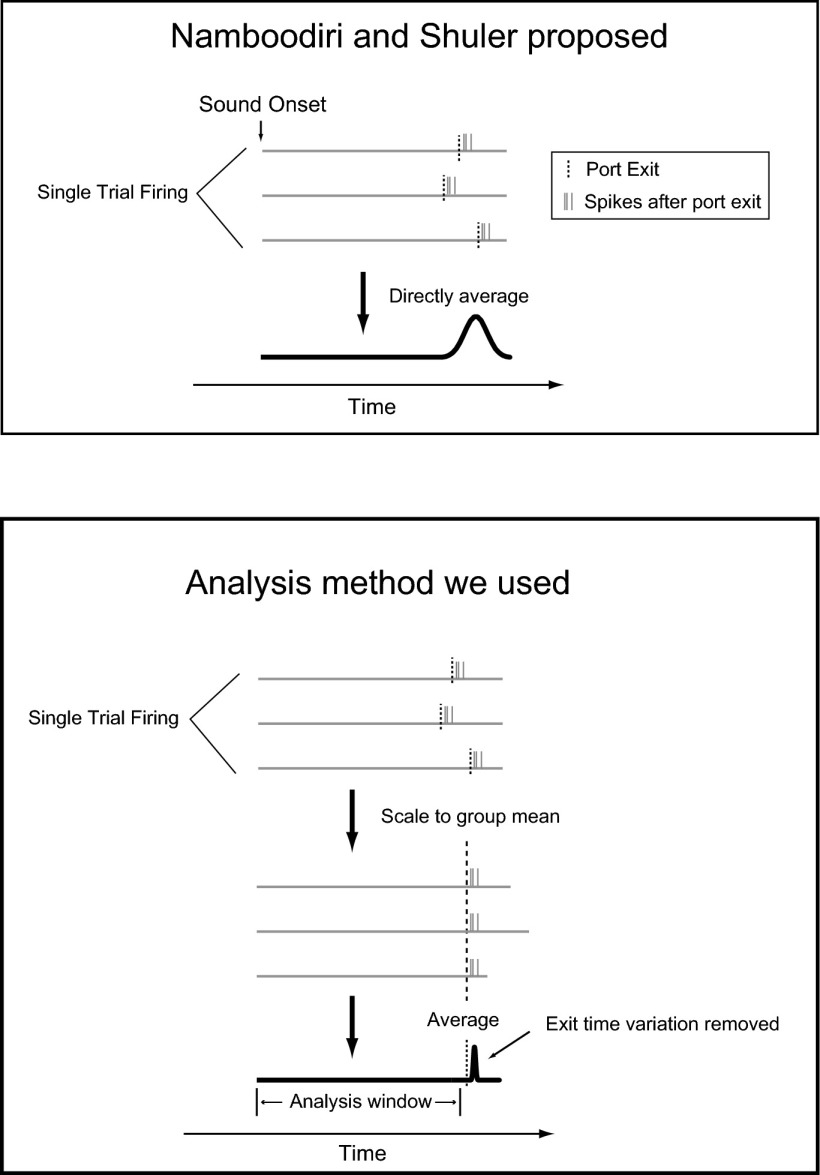Namboodiri and Hussain Shuler (1) propose an alternative explanation for the timing-related firing rate modulation of medial prefrontal cortex (mPFC) neurons, suggesting that our finding can be simply explained by mPFC neuronal activity evoked by port exit (2). To illustrate their argument, the authors describe a thought experiment in which a flash of light is presented to the animal at the time of port exit. The authors predict that the visually evoked responses, when aligned to the sound onset and averaged across trials, will give rise to peri-event time histogram with an apparent scaling property because of the scaled variability of exit times across trials. This prediction is incorrect, as a crucial step was included in our analysis designed specifically to eliminate this confound. As described in the Materials and Methods of ref. 2, spike rate in each individual trial was temporally scaled to the mean exit time to remove variability introduced by the variation in the exit time (Fig. 1). Using this analysis, the peri-event time histogram obtained from the above thought experiment should not exhibit the scaling property as that shown in figure 3 of ref. 2, because the visually evoked activity (occurring after the exit) will fall outside of our analysis window. For the same reason, although some mPFC neurons do exhibit transient firing at port exit, our temporal scaling of individual trials before averaging means that these peaks fall outside of the analysis window, because most of the spike occurred after port exit. To further minimize the potential confound by the transient activity associated with port exit, the period of 100-ms before the port exit was also excluded from our analysis window (figure 3D of ref. 2). Together, these steps preclude the trivial explanation proposed by Namboodiri and Hussain Shuler (1).
Fig. 1.
Schematic diagrams for data analysis. Upper shows the method proposed by Namboodiri and Hussain Shuler (1). Lower shows the method used by Xu et al. (2).
Namboodiri and Hussain Shuler (1) point out that the effect of cooling on port exit time could reflect impaired sensory processing or slowed decision making. We would like to point out that the rats preformed the interval timing task during cooling with high accuracy, suggesting that the effect is not a result of gross impairment of the cognitive processes involved in this behavior. More importantly, the purpose of the cooling experiment was to test the causal role of mPFC activity in this interval-timing behavior, which complements the correlation between mPFC activity and behavioral timing established in the recording experiments. Thus, although based on the cooling experiment alone it is difficult to exclude the possibility that other effects, such a slowed decision making, could also contribute to the delayed port exit, together with the temporally scaled firing-rate modulation observed in the recording experiments, this study points to an important role of mPFC in interval-timing behavior.
Supplementary Material
Footnotes
The authors declare no conflict of interest.
References
- 1.Namboodiri VMK, Hussain Shuler MG. Report of interval timing or action? Proc Natl Acad Sci USA. 2014;111:E2239. doi: 10.1073/pnas.1404555111. [DOI] [PMC free article] [PubMed] [Google Scholar]
- 2.Xu M, Zhang SY, Dan Y, Poo MM. Representation of interval timing by temporally scalable firing patterns in rat prefrontal cortex. Proc Natl Acad Sci USA. 2014;111(1):480–485. doi: 10.1073/pnas.1321314111. [DOI] [PMC free article] [PubMed] [Google Scholar]



